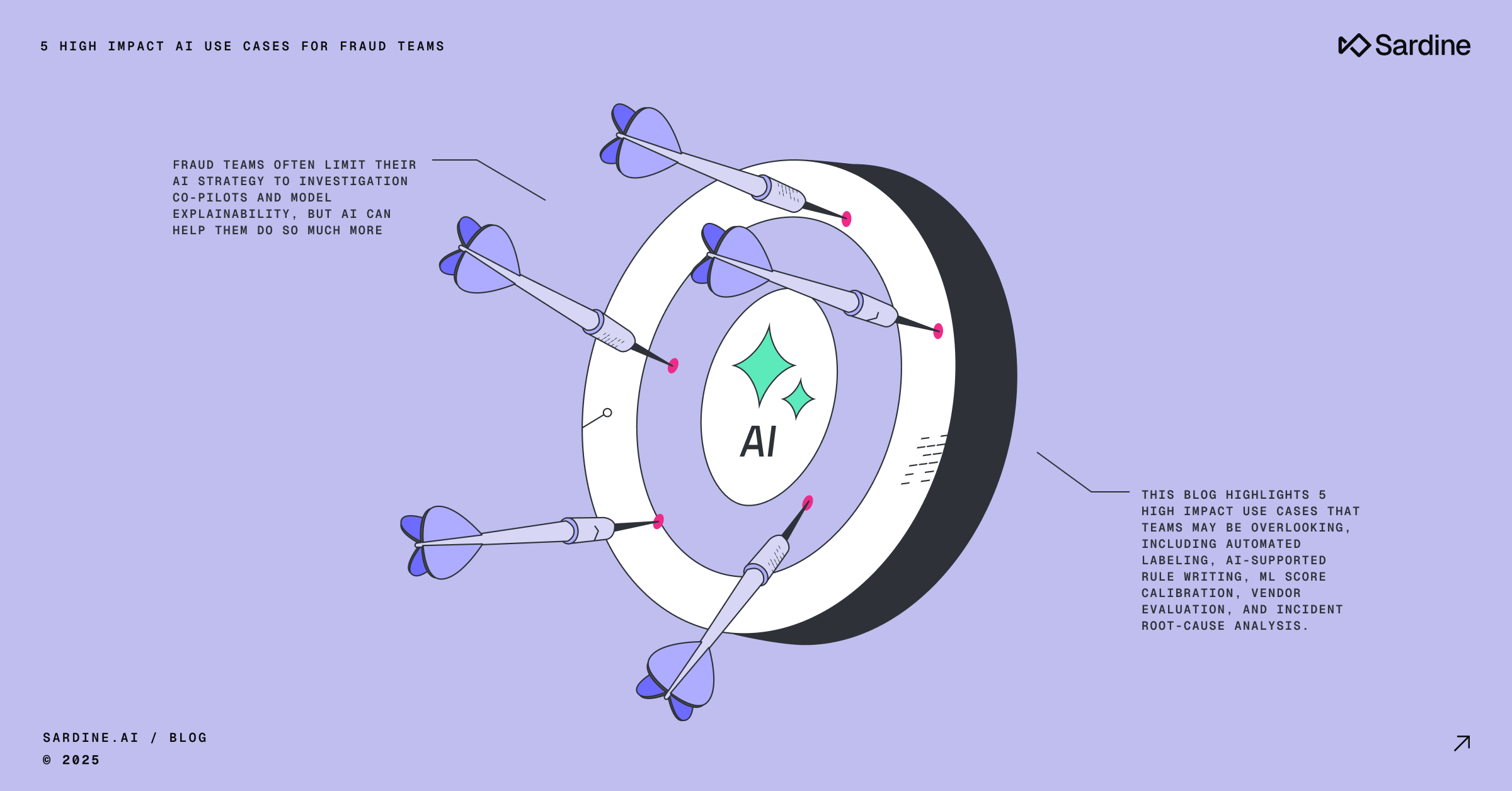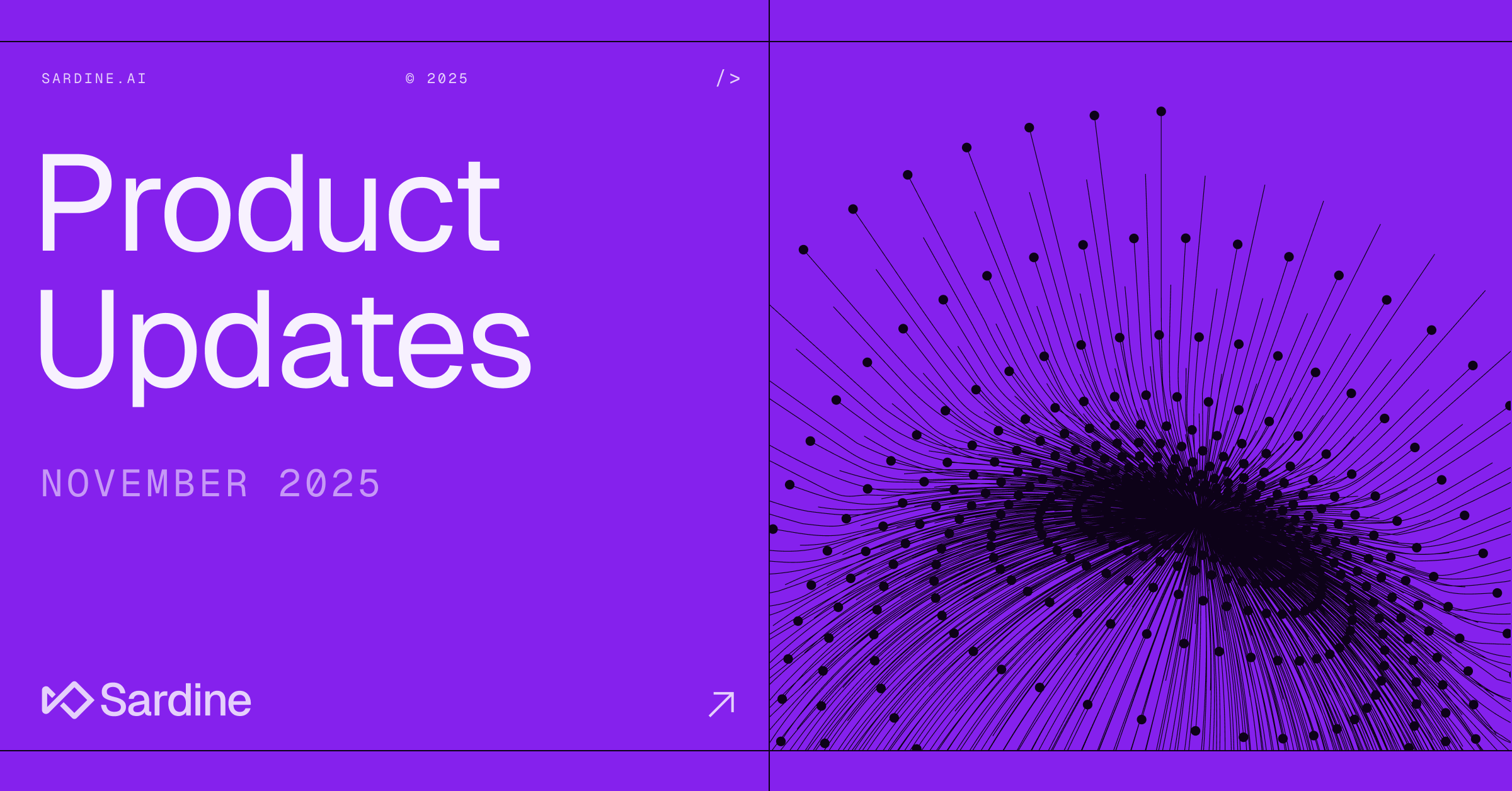Sardine Risk Platform Updates - April 2023
At Sardine, we've been working hard to build meaningful enhancements to our risk platform, from our new capabilities like Network Graph to Business Verification. In this month's product update, we’re sharing a few highlights of what shipped in April 2023:
Summary
📋 New Features
- 🌐 Network Graph
- 📝 Business Verification
- 💰 Crypto Wallet Screening
🚀 Improvements
- 📊 Dashboard
- 📜 Rule Engine & Editor
- 🕵️♂️ Fraud Risk
- 💳 Issuing Risk
- 📄 Document Verification
- 🔍 Review Queues
- 👨👦👦 Parent-Child Accounts
📋 New Features
1. Network Graph

Our new Network Graph is now available to all merchants. This latest update includes improvements to our side panel and node types. The Network Graph is under the Network tab on the Customer details page. To learn more, contact your Sardine Strategic Account Manager (AM).
2. Business Verification

Our new Businesses API allows you to verify unique or existing U.S. businesses for business verification and screening. We’re starting with U.S. business registration and Tax ID Number (TIN) verification via the Secretary of State (SOS). In subsequent phases, Sardine will update this feature to support more complex verification flows and verification and screening of beneficial owners and non-US business entities.
To learn more, visit our API documentation here or contact your Sardine Strategic Account Manager (AM).
3. Crypto Wallet Screening

Our cryptocurrency wallet screening feature allows merchants to screen blockchain wallets for compliance risk. Merchants can send us crypto wallet addresses for over 90+ blockchains, including UTXO and EVM-based networks, and monitor for activity across 900+ assets and related on-chain activity.
To learn more, visit our API documentation here or contact your Sardine Strategic Account Manager (AM).
🚀 Improvements
4. Dashboard

- New “Transaction Recipient” widget
If you provide recipient details in the API request (e.g. if a consumer is making a fiat or crypto off-platform transaction), we can now surface these details on the session details page. - Display bank reason codes
Bank reason codes already being returned for bank transaction events are now shown on the session details page. This will help with investigations by clearly displaying reason codes that might have resulted in specific rules triggering. The latest list of reason codes is available here. - Link to filtered Customer Intelligence page
The session details page’s email address, phone number, and IP address is now linked to the Customer Intelligence filtered to that specific email, phone, or IP address. This facilitates investigating other sessions with the same email, phone, or I.P. address.
5. Rule Engine & Editor

- New Custom List function in the rule editor
A new ListItemMatch function has been added to the rule editor to create rules based on Custom List entry items. This function allows you to check any rule engine field against items from a Custom List as a condition to any rule. - New rule-level allowlist indicators
If a rule has been allow listed for a specific session, we will now show an “Allowlisted” label next to the rule name in the sessions’ “Executed Rules” section. Since the rule is allow listed, the rule’s risk level will not be considered in the overall session risk level. A new “ALWR” reason code will also be shown at the top of the session detail page if at least one allow listed rule was triggered. The latest list of reason codes is available here.
6. Fraud Risk
- New email domain option for block/allow listing
In addition to the existing individual email address, you can now blocklist/allowlist on the email domain (e.g., sardine.ai). The new “Email Domain” type option will now be available when adding an item under the Lists page. - New Referral Code features
- User.ReferralCodeAggregations.CustomerIdCount (1HR, 1DAY, 1WEEK) - total number of customers associated with this referral code within the selected timespan
- User.ReferralIssuerId - I.D. of the user who issued the referral code
7. Issuing Risk
- New merchant and card-level transaction aggregation features
We have added four new velocity aggregation features: - MerchantAggregation.TransactionAmount (15MIN, 1HR, 1DAY, 1WEEK) - total transaction amount for this merchant I.D. within the specifiedfourtimespan
- MerchantAggregation.TransactionIdCount (15MIN, 1HR, 1DAY, 1WEEK) - total transaction count for this merchant I.D. within the specified timespan
- CardMerchantAggregation.TransactionAmount (15MIN, 1HR, 1DAY, 1WEEK)I.D. - total transaction amount for this merchant ID and card I.D. within the specified timespan
- CardMerchantAggregation.TransactionIdCount (15MIN, 1HR, 1DAY, 1WEEK)I.D. - total transaction count for this merchant ID and card I.D. within the specified timespan
8. Document Verification
- New Document Verifications CSV export option
An “Export CSV” button has been added to the Document Verifications page to download data from the latest 1000 document verification into a CSV file. This file includes data such as the different risk levels (e.g., Risk Level, Forgery Level, Face Match Level), extracted data (e.g., document type, country, name), and identifiers (e.g., customerId, verificationId...). - New Document Verifications First/Last name filters
The Document Verifications page list can now be filtered based on the first name and last name extracted from the document. Those are also shown in the Document Verification page list under the “First Name” and “Last Name” columns.
9. Review Queues
- Display Customer Name in cases list view
The Customer Name (based on the first name and last name data sent to Sardine) is now shown in the case list view for each queue to help streamline the case status review process. - New list view filter for Review Queues
The Review Queue list view can now be filtered for different time frames and by who the case is assigned (by selecting a specific user under the “UserAssigned” filter option).
10. Parent-Child Accounts
- New subaccounts API
If integrated as a parent-child account structure, merchants can now provision new children accounts directly via API with this new /v1/subaccounts API endpoint. This API will return the newly created child accounts’ clientId, which can then be used to generate a new API secret using the new /v1/subaccounts/secrets API endpoint. - New parent-level webhook URL support
If integrated as a parent-child account structure, merchants can now have all webhook events from the merchant's child accounts sent to the same parent-level configured webhook URL. This allows you to manage all events through a single endpoint and signature key. The originating child account clientId is included in the webhook payload. - New parent-level queues support
If integrated as a parent-child account structure, merchants can now create queues at the parent account level that will show relevant cases from any child account. This allows you to centralize review queue management at the parent account level.



%20(1).png)



.png)




